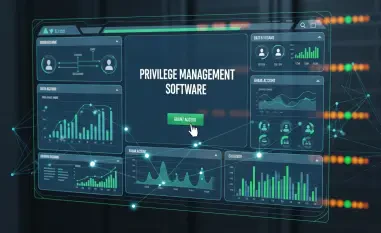Imagine a world where access control systems operate with split-second precision, even in the face of network failures or cyber threats, ensuring that critical facilities like hospitals or data centers remain secure under any circumstances. This is no longer a distant vision but a reality shaped by edge intelligence, a groundbreaking technology redefining physical security. As global security demands escalate amid rising cyber risks and the need for real-time responses, this review explores how edge intelligence transforms access control by decentralizing decision-making and enhancing resilience. The focus will be on its core features, real-world impact, and the challenges it must overcome to solidify its place in the security landscape.
Understanding the Rise of Edge Intelligence
Edge intelligence marks a pivotal shift in access control systems, moving away from centralized architectures to decentralized models where decisions are made closer to the point of action. Unlike traditional setups that depend on constant communication with central servers, this technology empowers local controllers to process data independently. This evolution has emerged from the pressing need to address modern security challenges, such as network latency and the risk of system-wide failures during outages.
The broader context of this innovation lies in the integration of security with the Internet of Things (IoT) and the growing complexity of threat landscapes. As organizations demand faster, more reliable systems to protect assets and ensure operational continuity, edge intelligence stands out as a cornerstone of next-generation security. Its ability to function autonomously positions it as a vital component in an era where digital and physical security are increasingly intertwined.
Core Features and Functionalities
Local Decision-Making and Real-Time Efficiency
One of the standout capabilities of edge intelligence is its support for local decision-making, allowing access controllers to process commands without relying on a central server. This means operations like unlocking doors or triggering alarms happen almost instantaneously, as embedded applications on the hardware handle tasks directly. Such reduced latency is critical in high-stakes environments where every second counts, ensuring that security protocols are executed without delay.
Beyond speed, this feature enhances system resilience. In scenarios where network connectivity is disrupted—whether due to technical failures or deliberate attacks—local processing ensures that essential functions continue uninterrupted. This autonomy not only boosts operational efficiency but also builds a robust defense against vulnerabilities that could compromise entire systems in centralized setups.
Seamless Integration with IoT and Supporting Systems
Another defining strength of edge intelligence lies in its compatibility with IoT ecosystems and auxiliary security components. By connecting with devices like smart cameras, sensors, and elevator controls, it creates a cohesive security framework that can respond dynamically to evolving situations. This integration enables advanced functionalities, such as correlating video analytics with access events to detect unauthorized entries in real time.
The technical foundation of these integrations often involves standardized protocols that ensure smooth communication across diverse hardware. This interoperability translates into tangible performance benefits, including enhanced situational awareness and streamlined management of complex facilities. Ultimately, the ability to unify disparate systems under a single intelligent architecture amplifies the overall effectiveness of security measures.
Cutting-Edge Developments
Recent advancements in edge intelligence reflect a broader industry trend toward decentralization and autonomy in security solutions. Innovations in hardware, such as more powerful processors embedded in controllers, have significantly boosted local computing capabilities. These developments enable controllers to handle increasingly sophisticated tasks, from real-time analytics to predictive threat detection, without external support.
Additionally, there is a noticeable shift in market behavior, with organizations prioritizing low-latency, standalone systems over traditional models. This preference is driven by global security challenges, including the rise of ransomware and other cyber threats that expose the weaknesses of centralized architectures. As a result, manufacturers are focusing on creating solutions that balance advanced functionality with robust, independent operation.
A key influence on these trends is the ongoing digital transformation across industries, pushing the demand for systems that can adapt to dynamic environments. From 2025 onward, the next few years are expected to see further enhancements in processing power and software optimization, ensuring that edge intelligence remains at the forefront of security innovation.
Practical Implementations Across Industries
Edge intelligence has found significant traction in various sectors, demonstrating its versatility through real-world applications. In smart cities, for instance, it underpins access control for public infrastructure, enabling rapid responses to security incidents in densely populated areas. Controllers equipped with this technology manage entry points at transit hubs and civic buildings, ensuring safety without reliance on constant cloud connectivity.
In healthcare and government settings, the technology proves invaluable for protecting sensitive environments. Hospitals use it to secure restricted areas like pharmacies or patient wards, where immediate access decisions are often critical. Similarly, in critical infrastructure across the Asia-Pacific region, edge intelligence supports remote facilities such as industrial zones, maintaining security despite inconsistent network conditions.
These deployments highlight the technology’s unique value in addressing diverse needs. Whether facilitating smart infrastructure or safeguarding high-risk locations, its ability to operate independently while integrating with broader systems showcases a transformative impact on how security is managed globally.
Obstacles and Constraints
Despite its promise, edge intelligence faces several challenges that could hinder widespread adoption. Technical limitations, such as ensuring consistent performance across varied environments, pose a significant hurdle. Factors like hardware disparities or environmental conditions can affect reliability, necessitating ongoing refinements to maintain uniform standards.
Cybersecurity risks also loom large, as increased connectivity with IoT and other systems expands the attack surface. Without stringent safeguards, edge devices could become entry points for malicious actors, undermining the very security they aim to enhance. Efforts to counter these threats include adopting advanced encryption and authentication protocols, though implementation remains uneven across markets.
Market barriers, including the high initial costs of deployment, further complicate the landscape. Smaller organizations may struggle to justify the investment, even with long-term benefits in mind. Industry initiatives to develop cost-effective solutions and standardized frameworks are underway, aiming to lower these barriers and foster broader acceptance.
Outlook for Tomorrow
Looking ahead, edge intelligence holds immense potential to redefine security paradigms through continued innovation. Breakthroughs in processing capabilities are anticipated, enabling even more complex tasks to be handled locally with minimal latency. Such advancements could unlock new applications, from predictive security measures to fully autonomous access systems.
Integration capabilities are also expected to evolve, allowing deeper synergy with emerging technologies like artificial intelligence and machine learning. This could lead to smarter, more adaptive security frameworks that anticipate threats before they materialize. Over the long term, these developments will likely shape a security industry that prioritizes resilience and flexibility in response to ever-changing risks.
The trajectory of this technology suggests a future where decentralized systems become the norm, fundamentally altering how organizations approach protection. As digital transformation accelerates, edge intelligence is poised to play a central role in building robust, responsive solutions tailored to the complexities of modern threats.
Final Reflections
Looking back, this exploration of edge intelligence revealed a technology that has already begun to revolutionize access control with its focus on local decision-making and integration prowess. Its capacity to enhance real-time efficiency and resilience stood out as a game-changer across industries. Challenges like cybersecurity risks and adoption costs were evident, yet the strides made in addressing them underscored a maturing field.
For organizations aiming to stay ahead, the next step involves investing in scalable, cyber-hardened edge solutions that align with open standards to ensure adaptability. Collaborating with industry stakeholders to refine protocols and reduce implementation barriers will be crucial. As the security landscape continues to shift, leveraging this technology to build autonomous, integrated systems offers a proactive path to safeguarding assets in an increasingly complex world.













